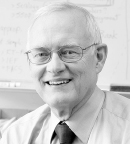Over the past few decades, our understanding of transplant immunology has moved from basic allograft rejection to the current molecular level that offers life-saving treatments for patients with cancer. The scientific elegance of this remarkable therapy’s arc from experimental to standard of care is the result of laboratory and clinical researchers, one of whom was John Hansen, MD, whose work demonstrated, among other things, how genetic variation in the immune system contributes to the success or failure of a bone marrow transplant.

John Hansen, MD
Dr. Hansen also defined immunologic rules for finding suitable transplant donors, and in doing so, he founded repositories of patient samples and clinical data that have become vital research resources for improving outcomes for patients receiving transplants. Largely because of his leadership in this field, tens of millions of people are now listed in these registries, and at least 1.3 million transplants of blood-forming stem cells or bone marrow have been performed worldwide. Dr. Hansen died of pancreatic cancer on July 31, 2019. He was 76.
An Early Love of Science
Dr. Hansen was born on May 1, 1943, in Minneapolis. His father was a Lutheran minister, and his mother was a nurse.
As a boy, Dr. Hansen showed a keen interest in science, excelling throughout his early school career. After graduating high school, Dr. Hansen entered the University of Minnesota, graduating in 1965 with a degree in biology.
He then went to Stanford University School of Medicine, earning his medical degree in 1965. Dr. Hansen had originally planned to specialize in cardiac surgery and had the opportunity during medical school to work in the laboratory of health-transplant pioneer, Norman Shumway. However, during this period, he observed that Dr. Shumway’s team was facing a persistent obstacle: immunologic rejection of the transplanted heart.
At the time, Dr. Hansen was set to undertake a cardiac surgery fellowship at Stanford University, but he postponed the fellowship and took advantage of an opportunity in London to learn immunology and perhaps use that knowledge to tackle the rejection issue. Nevertheless, there was much more to be learned, and he returned to the University of Minnesota to study immunology with Robert A. Good, MD, the physician who performed the first successful human bone marrow transplant between patients who were not identical twins. That experience convinced Dr. Hansen to switch specialties, as he realized that replacing the body’s immune system offered huge potential for transplant and other treatments of disorders such as blood diseases.
Bone Marrow Donor Registry
Dr. Hansen’s career blossomed at Fred Hutchinson Cancer Research Center (Fred Hutch) in Seattle. He joined the Center in 1977 and would conduct his groundbreaking research with other luminaries, such as transplant pioneer, Nobel Laureate E. Donnall Thomas, MD, who led a small team at the newly formed Center, working on bone marrow transplantation when it was still considered an experimental therapy.
As his research gathered momentum, Dr. Hansen would become head of the clinical tissue-typing lab at Fred Hutch’s transplant program. He also was appointed Senior Vice President and Director of the Clinical Research Division and Head of the Human Immunogenetics Program, and he assumed the directorship of the Clinical Immunogenetics Laboratory at Seattle Cancer Care Alliance.
At Fred Hutch, Dr. Hansen’s tissue-typing laboratory also made possible the first transplant for leukemia with an unrelated donor—10-year-old Laura Graves—in 1979. Dr. Hansen’s trailblazing procedure fueled the Graves family’s dedicated advocacy, which was the driving force behind the National Marrow Donor Program (NMDP), founded in 1986. Dr. Hansen led the three-person team that organized and launched the registry, which was intended to facilitate donor matches between strangers. He served on the NMDP’s Board of Directors from 1988 to 2004 and also led the program’s creation of a repository of paired samples from transplant patients and donors.
In an interview about his seminal work with the NMDP, Dr. Hansen said, “Every patient I’ve known, every patient I’ve helped … every one of them is a precious experience, a real sense of accomplishment. But getting the national registry started was also like that.”
Tributes From Colleagues
Fred Hutch President and Director Gary Gilliland, MD, PhD, remarked, “The contributions that John made in the field of hematopoietic stem cell transplantation were extraordinary. His work extended transplantation on a global scale. Measured in the number of human lives saved, few physician-scientists have had the impact that he had during his lifetime and will continue to have.”
“John was a scientific pioneer and a true gentleman—a powerful combination.”— Nancy E. Davidson, MD, FASCO
Tweet this quote
Past ASCO President and Senior Vice President and Director of the Clinical Research Division at Fred Hutch, Nancy E. Davidson, MD, FASCO, had this to say: “John was a scientific pioneer and a true gentleman—a powerful combination. Countless patients and families benefited from his expertise and his compassion. I am grateful for his legacy to the field of stem cell transplantation and to Fred Hutch.”
Ambition Tempered by Humility
His associates and many friends at Fred Hutch remembered Dr. Hansen as a quiet man, one who listened more than he talked. Colleagues who worked with him for decades can’t remember ever hearing him raise his voice in anger. Always steady and systematic in his science, Dr. Hansen was capable of great bounds of creativity, colleagues noted—qualities that they say undoubtedly helped him advance research in the face of the many great challenges of early transplant science.
In a 2018 Fred Hutch profile, Dr. Hansen noted that the potential for transplantation to save lives from incurable diseases was so important to him that sometimes he worked throughout the night. “It was so novel and exciting in what it meant for big breakthroughs for patients,” he said.
Dr. Hansen’s first wife, Mary Ann (Wilson) Hansen, died of cancer in the early 1990s. He is survived by three children from that marriage, Eric and Peter Hansen and Connie Jenson; a son, Nicholas, from his marriage to Suzanne Gobeille; and seven grandchildren. ■

